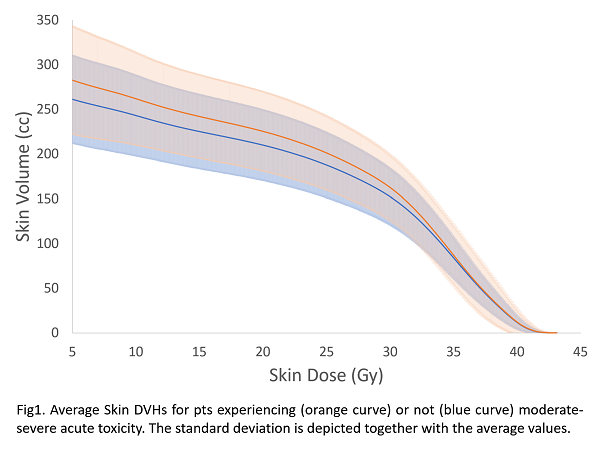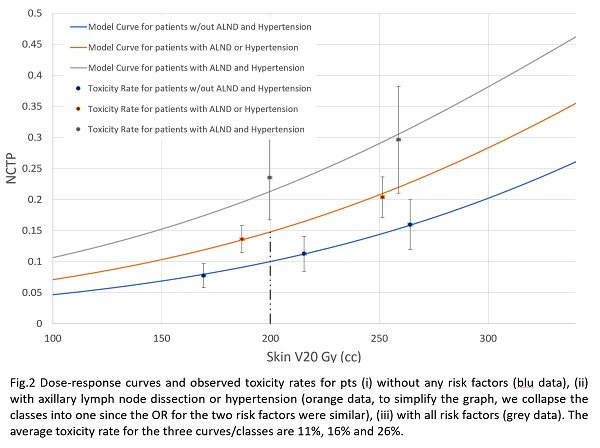Dosimetry Predictors of Acute Skin Reactions after Whole Breast Radiotherapy
Alessandro Cicchetti,
Italy
OC-0453
Abstract
Dosimetry Predictors of Acute Skin Reactions after Whole Breast Radiotherapy
Authors: Alessandro Cicchetti1,2, Paola Mangili3, Andrei Fodor4, Martina Mori3, Anna Chiara4, Chiara Deantoni4, Marcella Pasetti4, Gabriele Palazzo4, Maria Giula Ubeira Gabellini3, Tiziana Rancati2, Antonella Del Vecchio3, Nadia Gisella Di Muzio4, Nadia GIsella Di Muzio4, Claudio Fiorino3
1San Raffaele Scientific Institute, Medical Physics, Milano, Italy; 2Fondazione IRCCS Istituto Nazionale dei Tumori di Milano, Prostate Cancer Program, Milan, Italy; 3San Raffaele Scientific Institute, Medical Physics, Milan, Italy; 4San Raffaele Scientific Institute, Radiotherapy, Milan, Italy
Show Affiliations
Hide Affiliations
Purpose or Objective
Skin alterations and dermatitis events are usually mild and resolved after the end of breast RT. Still, for some patients experiencing moderate toxicity, the effects can be prolonged and lead to chronic symptomatology. Here, we proposed an NTCP model predicting skin toxicity using dosimetric parameters from the breast dermis to identify possible RT constraints and radiobiological assumptions on such structure.
Material and Methods
The skin structure was defined as the 5 mm inner isotropic expansion from the outer CT body contour. It was retrospectively segmented on a large cohort of early-stage breast cancer patients treated between 2009 and 2017 in a single institution. Patients were treated with tangential field RT, delivering 40 Gy in 15 fractions to the whole breast without bolus application or dose boost. We preliminarily investigated the impact of changes in the dose calculation algorithms with time. Automatic delineation of the structures and DVH extractions were accomplished by scripting using the MIM_assistant software.
Toxicity was reported during FU using RTOG scoring criteria. The study endpoint was moderate-severe acute reactions (ACUG2+) developed within the first 3 months after RT completion. The NTCP model using logistic regression was created by combining dosimetry and clinical factors. A 5-fold cross-validation preserving the imbalance class distribution in each fold was applied.
Results
One-hundred-twenty-six patients representing 14.4% of the considered population (n=878 pts) reported ACUG2+ toxicity (13.2% of G2 and 1.2% of G3 events), manifesting at least bright erythema, patchy moist desquamation or moderate oedema. Average DVHs for patients with and without toxicity are depicted in Fig1.
A significant association with ACUG2+ was found in univariate analysis for PTV volume, hypertension, diabetes, obesity, axillary lymph node dissection (ALND), and V5 to V34 Gy. We defined a multifactorial model including V20 Gy (OR=1.008,p<0.0001), hypertension (OR=1.54, p=0.030) and ALND (OR=1.58, p=0.045). We performed the final selection for the dosimetric variable based on correlations, the impact of the dose calculation algorithms and clinical application (V20 Gy represents 50% of the prescribed dose as other constraints in breast cancer RT, and it is an early point in the plateau of the dose distribution). AUC for the model was 0.63 (0.60-0.67, p<0.0001). The resulting dose-response curves are shown in Fig.2. A cut-off of 200 cc to Skin V20 Gy can be applied to limit the toxicity to 10%-15% in low and intermediate-risk classes.


Conclusion
The association between moderate-severe acute skin reactions and skin DVH was quantified. For the first time to our knowledge, the current study identified dose-volume warnings for a structure usually not considered during plan optimization. Our findings should help planners to obtain more conformal dose distributions in high-risk pts with large breast and/or with tissue impaired by hypertension and/or previous removal of axillary lymph nodes.
The study was funded by AIRC IG 25951 – 23150 and Fondazione Regionale per la Ricerca Biomedica project nr. 110-JTC PerPlanRT ERA PerMed, GA 779282.